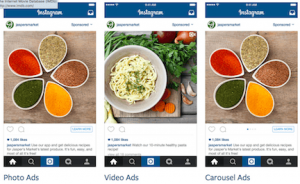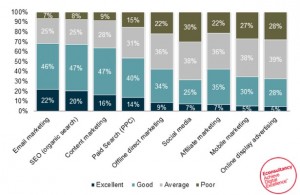Looking for the business disciplines seeing the most rapid change and innovation? Contributor Scott Brinker examines where traditional departments are crossing each others’ boundaries.

The most exciting developments in marketing today are happening at intersections.
For instance, a growing profession of marketing technologists have emerged from the intersection of marketing and IT. Marketing technologists combine technical skills — programming, systems design, algorithmic thinking, and technology management and strategy — with a passion for marketing and customer experience.
At first, they seemed like odd ducks that didn’t quite fit into the structure of either IT or marketing. Their IT colleagues thought marketing was spin. Their marketing colleagues thought IT was plumbing. It was the corporate version of The Two Cultures by C.P. Snow.
But it turned out that having one foot in each of those worlds was a feature, not a bug. These hybrids were able to be a bridge between the two disciplines: translating concepts, identifying synergies and building rapport.
As digital marketing, powered by a dizzying array of marketing software, exploded in scope and scale, marketing technologists became the linchpins in marketing agility and effectiveness.
Unlocking those capabilities, however, required changes in organizational thinking.
Technical talent had never before primarily operated in the marketing department rather than in IT. There was great benefit in this re-imagined intersection of marketing and IT, but to unlock it, we had to experiment with and embrace new ways of working.
Marketing Is Redefining Intersections Everywhere
Similarly, re-imagined intersections with marketing are now blossoming across the organization.
Now that buyers engage with sellers more frequently through self-service marketing channels rather than through personal interactions with salespeople, the intersection between marketing and sales is ripe for innovation.
Indeed, one of the hottest categories for marketing technology today is sales enablement.
Instead of simply handing off prospects from marketing to sales, tossing them over a wall, these new tools enable marketing and sales to collaborate more closely throughout the buyer’s journey.
But harnessing these new tools requires new innovations in the processes between the two teams. Enter the opportunity for hybrid sales and marketing professionals, combined marketing/sales operations roles, and “sales technologists.”
Customer service is another fascinating intersection, catalyzed primarily by social media.
Customers expect resolutions to problems through these channels, and in the process, publicly frame the brand. Social media monitoring and management tools have been thriving as a result, and are often best run via a collaboration between marketing and service teams.
Increasingly, marketing automation platforms — originally focused primarily on customer acquisition — are now being applied to the onboarding of new customers and ongoing customer retention campaigns.
But this calls for new collaborations between the technologists configuring and operating these tools, the creative teams who know how to produce compelling programs in them, and the people who have responsibility for customer satisfaction and loyalty.
Finance and marketing are now working more closely together too, as marketing pursues an evolution from a traditional cost center to more of a dynamic revenue generation function.
Exciting new technologies for attribution and financial modeling of marketing programs are emerging, but again, to thrive, it requires humans who are willing to bridge marketing and finance teams with a common language and a shared set of definitions and metrics.
Even human resources and marketing are discovering new opportunities to connect across traditional boundaries, as the war for talent demands more marketing power applied to recruiting and retention.
Internal social networking systems have become all the rage, with many new start-ups targeting the hybridization of social media marketing and intracompany communications.
Remixing Multiple Marketing Disciplines
This phenomenon of hybrid marketing innovation goes beyond just organizational remixing and overlaps.
The very goal of omni-channel marketing — admittedly, still more of an ideal than a reality for most marketers — is to engage with customers in campaigns and programs that synchronize messages and experiences across many different touchpoints.
This isn’t just about repeating the same thing in email, your website, and call center interactions. It’s about orchestrating different elements in different channels so that collectively they deliver cohesive stories — with a new kind of hybrid storytelling.
The Internet of Things, though it’s admittedly in danger of being prematurely hyped, will arguably be the epitome of such multi-channel intersections — interconnecting digital and physical experiences. The creative opportunities that will afford marketers to invent new kinds of interactive experiences.
Interactive content marketing is another fascinating example of two different kinds of disciplines — content marketing and app-like user experience (UX) design — being combined in exciting new ways. (Disclosure: My company, ion interactive, provides software for marketers to build and deploy interactive content.)
As I’ve written about earlier here, this 4th wave of content marketing gives marketers the ability to experiment with entirely new kinds of mechanisms for customer engagement. Marketers can draw inspiration from eclectic sources such as experiential education and game design to redefine the concept of what “marketing content” is.
Combinatorial Innovation Grows Exponentially
Erik Brynjolfsson and Andrew McAfee, authors of The New York Times bestseller The Second Machine Age, argue that combinatorial innovation is one of the best reasons to be optimistic about the future.
Every time something new is invented, we don’t just gain the benefit of that new invention. We also gain a new set of possibilities for applying that innovation to existing products and services.
This creates an exponential explosion of hybrid ideas, each of which can spawn further new innovations, and so on, in a virtuous cycle of imagination.
For instance, Facebook was an innovation in social media in its own right. But the new ways that businesses have figured out how to interact with their prospects and customers through Facebook represent a whole new set of combinatorial innovations in content and commerce.
Another bestselling book, The Medici Effect by Frans Johansson, illustrates many of the breakthroughs that have been possible in history by the accidental intersection of disciplines, cultures, and industries — and passionately makes the case for deliberately inciting such cross-fertilization between seemingly unrelated concepts.
Marketing is experiencing a true Renaissance — it’s the digital Florence of our time, only a million times larger in scale — and the only thing required to tap into this powerful engine of innovation is a willingness to dream and experiment.
Marketing Land – Internet Marketing News, Strategies & Tips
(351)
Report Post






